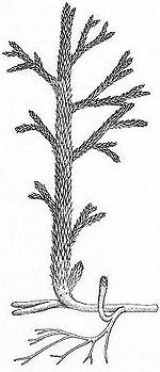
Asteroxylon
Encyclopedia
Asteroxylon is an extinct genus of plants of the Division Lycopodiophyta
known from anatomically preserved specimens in an Early Devonian
deposit of chert at Rhynie, Aberdeenshire in North-East Scotland that has been dated at . Asteroxylon is probably a stem group to the Drepanophycaceae
.
which flourished in the Early Devonian
period.
Dichotomously branching stems, which reached 12 mm in diameter and 40 cm in length, were erect, rising from a ground-running organ, from which also protruded underground "rhizoids" or "roots": these reached a depth of up to 20 cm below the surface. An actinostelic
vascular bundle occupied the centre of the axes, with tracheid
s being of primitive annular or helical type (so-called G-type). "Leaves" – not true leaves, but protrusions – were of the form of unbranched strap-shaped enations up to 5 mm long; a single vascular trace branched from the main bundle in the centre of the stem to terminate at the base of each enation. Enations and axes bore stomata, indicating that their tissues were capable of photosynthesis.
Asteroxylon differs from externally similar genera of the same period, Drepanophycus
and Baragwanathia
, in that the vascular thread extends well into the leaf in these genera. The leaves of Drepanophycus
and Baragwanathia
are therefore by definition true microphyll
s, while those of Asteroxylon
are not; see Drepanophycales
for more details.
Lycopodiophyta
The Division Lycopodiophyta is a tracheophyte subdivision of the Kingdom Plantae. It is the oldest extant vascular plant division at around 410 million years old, and includes some of the most "primitive" extant species...
known from anatomically preserved specimens in an Early Devonian
Devonian
The Devonian is a geologic period and system of the Paleozoic Era spanning from the end of the Silurian Period, about 416.0 ± 2.8 Mya , to the beginning of the Carboniferous Period, about 359.2 ± 2.5 Mya...
deposit of chert at Rhynie, Aberdeenshire in North-East Scotland that has been dated at . Asteroxylon is probably a stem group to the Drepanophycaceae
Drepanophycaceae
Drepanophycaceae is a family of extinct plants of the division Lycopodiophyta of Late Silurian to Late Devonian age , found in North America, China, Russia, Europe, and Australia.-Description:...
.
Description
Asteroxylon is a terrestrial genus of vascular plantVascular plant
Vascular plants are those plants that have lignified tissues for conducting water, minerals, and photosynthetic products through the plant. Vascular plants include the clubmosses, Equisetum, ferns, gymnosperms and angiosperms...
which flourished in the Early Devonian
Devonian
The Devonian is a geologic period and system of the Paleozoic Era spanning from the end of the Silurian Period, about 416.0 ± 2.8 Mya , to the beginning of the Carboniferous Period, about 359.2 ± 2.5 Mya...
period.
Dichotomously branching stems, which reached 12 mm in diameter and 40 cm in length, were erect, rising from a ground-running organ, from which also protruded underground "rhizoids" or "roots": these reached a depth of up to 20 cm below the surface. An actinostelic
Stele
A stele , also stela , is a stone or wooden slab, generally taller than it is wide, erected for funerals or commemorative purposes, most usually decorated with the names and titles of the deceased or living — inscribed, carved in relief , or painted onto the slab...
vascular bundle occupied the centre of the axes, with tracheid
Tracheid
Tracheids are elongated cells in the xylem of vascular plants that serve in the transport of water and mineral salts. Tracheids are one of two types of tracheary elements, vessel elements being the other. All tracheary elements develop a thick lignified cell wall, and at maturity the protoplast...
s being of primitive annular or helical type (so-called G-type). "Leaves" – not true leaves, but protrusions – were of the form of unbranched strap-shaped enations up to 5 mm long; a single vascular trace branched from the main bundle in the centre of the stem to terminate at the base of each enation. Enations and axes bore stomata, indicating that their tissues were capable of photosynthesis.
Asteroxylon differs from externally similar genera of the same period, Drepanophycus
Drepanophycus
Drepanophycus is a genus of extinct plants of the Division Lycopodiophyta of Early to Late Devonian age , found in Eastern Canada and Northeast USA, China, Russia, Egypt and various parts of Northern Europe and Britain.-Description:...
and Baragwanathia
Baragwanathia
Baragwanathia is a genus of extinct plants of the division Lycopodiophyta of Late Silurian to Early Devonian age , fossils of which have been found in Australia, Canada and China.-Description:...
, in that the vascular thread extends well into the leaf in these genera. The leaves of Drepanophycus
Drepanophycus
Drepanophycus is a genus of extinct plants of the Division Lycopodiophyta of Early to Late Devonian age , found in Eastern Canada and Northeast USA, China, Russia, Egypt and various parts of Northern Europe and Britain.-Description:...
and Baragwanathia
Baragwanathia
Baragwanathia is a genus of extinct plants of the division Lycopodiophyta of Late Silurian to Early Devonian age , fossils of which have been found in Australia, Canada and China.-Description:...
are therefore by definition true microphyll
Microphyll
The terminology of fossil plants is in places a little confusing. In the discipline's 200+ year history, certain concepts have become entrenched, even though improved understanding has threatened the foundations upon which they are based...
s, while those of Asteroxylon
Asteroxylon
Asteroxylon is an extinct genus of plants of the Division Lycopodiophyta known from anatomically preserved specimens in an Early Devonian deposit of chert at Rhynie, Aberdeenshire in North-East Scotland that has been dated at...
are not; see Drepanophycales
Drepanophycales
Drepanophycales is an order of extinct plants of the Division Lycopodiophyta of ?Late Silurian to Late Devonian age , found in North America, China, Russia, Europe, and Australia. Sometimes known as the Asteroxylales or Baragwanathiales....
for more details.

